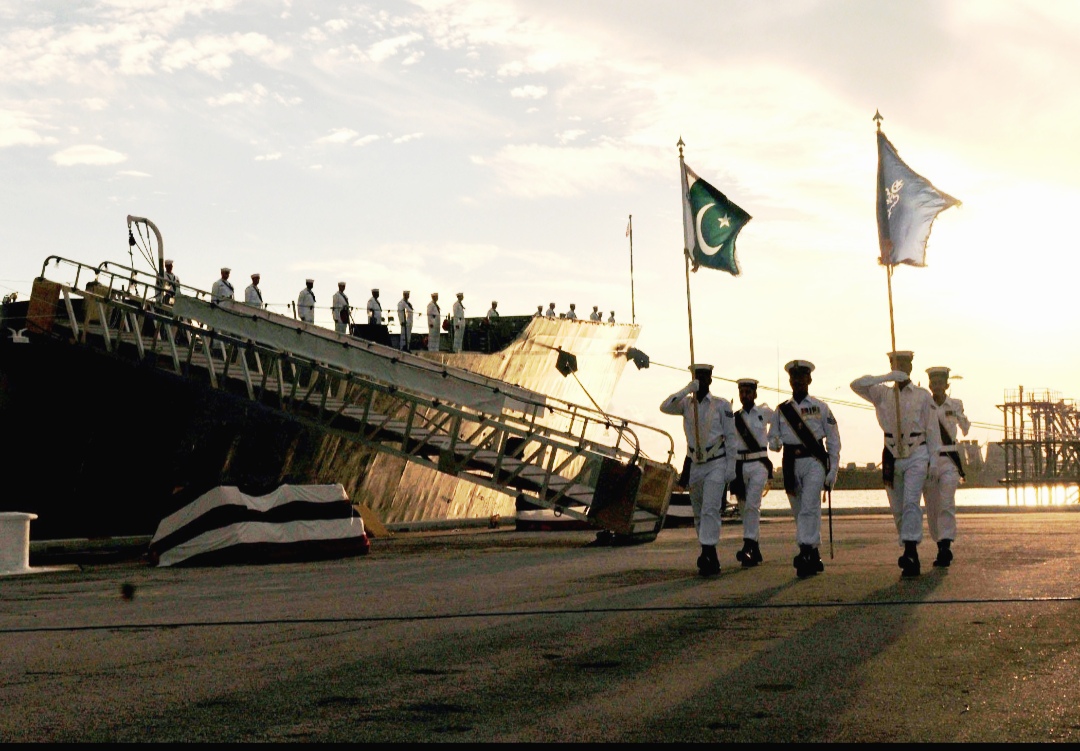In the wake of Operation Sindoor, Pakistan Navy’s fleet has become conspicuously absent from the Arabian Sea’s strategic waters. Open source reports and maritime tracking data reveal a troubling pattern: the majority of Pakistan Navy’s principal surface combatants remain pier-side at Karachi Naval Base, raising serious questions about operational readiness and the service’s ability to fulfil its maritime security mandate.
The Maintenance Crisis
The Pakistan Navy’s current predicament stems from a perfect storm of maintenance challenges that have rendered much of its fleet operationally compromised. Maintenance delays, unavailability of critical spare parts, and inadequate technical training from manufacturers have severely hampered operational readiness.
The aging fleet structure lies at the heart of these maintenance woes. Many of Pakistan’s principal surface combatants, including the Type-21 frigates acquired from the Royal Navy in the 1990s, are operating well beyond their intended service lives. These vessels require increasingly frequent and costly maintenance cycles, with spare parts becoming scarce and expensive as original manufacturers phase out support for legacy systems.
The situation is further complicated by Pakistan’s diversified procurement strategy, which has resulted in a fleet comprising Chinese, Turkish, American, and British-origin vessels. Each platform requires specialized maintenance protocols, unique spare parts inventories, and distinct technical expertise. This logistical complexity has overwhelmed Pakistan Navy’s maintenance infrastructure, creating bottlenecks that keep vessels tied to port for extended periods.
Chinese-origin vessels present particular challenges. Recent reports indicate that the stark reality confronting Pakistan’s naval planners is that their force remains fundamentally weak, constrained by its outdated technology, foreign dependence, and defensive orientation. The much-vaunted Type-054A frigates, delivered between 2021 and 2023, have experienced recurring technical issues with their radar systems and propulsion plants, requiring frequent returns to shipyard facilities.
Financial constraints have exacerbated these maintenance challenges. Pakistan’s defence budget allocation for naval operations has remained stagnant while maintenance costs have escalated. The Navy has been forced to implement a rotation system where only a fraction of the fleet remains operationally ready at any given time, while the remainder undergoes extended maintenance cycles.
Recent satellite imagery analysis has revealed the extent of this crisis. Military experts assert this presents a unique opportunity for India as these docked vessels could be strategic targets in an India-Pakistan war scenario, and the Indian Navy must neutralize them before they are made operational again. Reports indicate that Pakistan has only two operational submarines, with the rest inactive and berthed at naval facilities.
Limited Repair Capability and Shipyard Failures
The Pakistan Navy’s maintenance crisis is compounded by the severely limited repair capabilities of domestic shipyards. The Karachi Shipyard & Engineering Works Limited (KS&EW Ltd.), Pakistan’s primary naval repair facility, has struggled to meet the complex maintenance requirements of modern naval vessels. Despite being sponsored and owned entirely by the Ministry of Defence Production, with corporate leadership coming directly from Navy HQ, the facility lacks the sophisticated equipment and technical expertise required for advanced repairs.
The shipyard’s limitations became starkly apparent during recent attempts to service the Type-054A frigates. These Chinese-origin vessels require specialized diagnostic equipment and proprietary software that KS&EW lacks. Attempts to establish repair partnerships with Chinese firms have been hampered by technology transfer restrictions and exorbitant costs, leaving many vessels in extended maintenance limbo.
Historical precedent underscores these concerns. In 1995, the Poolster-class PNS Moawin was subjected to a serious fire accident that claimed valuable life during refitting at Karachi. This incident highlighted the shipyard’s inadequate safety protocols and emergency response capabilities – problems that persist today. Recent social media posts by naval personnel, shared on platforms including X (formerly Twitter), have anonymously highlighted ongoing safety concerns and equipment failures during maintenance operations.
The shipyard’s workforce challenges further exacerbate repair delays. Skilled technicians and engineers have increasingly sought opportunities in the private sector or overseas, leaving KS&EW with a workforce gap that directly impacts repair timelines. Projects that should take months now stretch into years, creating a backlog that has reached crisis proportions.
Leadership Crisis and Command Failures
The Pakistan Navy’s operational challenges are compounded by a deepening leadership crisis at multiple levels. Senior naval leadership has been criticized for failing to anticipate and address the maintenance crisis, with decision-making processes hampered by bureaucratic inefficiencies and risk-averse attitudes.
Recent command changes have done little to address systemic issues. The revolving door of senior appointments has created institutional instability, with each new leadership team spending valuable time learning their roles rather than implementing solutions. This lack of continuity has prevented the development of long-term strategic planning necessary to address the fleet’s maintenance backlog.
Middle management has been particularly affected by the crisis. Department heads and technical officers find themselves caught between unrealistic operational demands from senior leadership and the practical limitations of their equipment and personnel. Many have privately expressed frustration through social media channels, with anonymous posts on defense forums and X highlighting the disconnect between naval headquarters’ expectations and ground-level realities.
The command structure’s failure to adapt to modern maintenance requirements has created a culture of make-do solutions and temporary fixes. Rather than investing in proper repair capabilities, leadership has consistently opted for short-term measures that ultimately compound long-term problems. This approach has created a cycle where vessels return to service only to experience recurring failures within months.
Logistical Nightmare
The Pakistan Navy’s logistical challenges represent perhaps the most critical aspect of its current crisis. The service’s supply chain management has proven inadequate for supporting a modern naval fleet, with procurement delays and inventory shortages becoming endemic.
Spare parts availability remains the most pressing logistical challenge. The Navy’s diverse fleet composition, spanning Chinese, Turkish, American, and British systems, requires an incredibly complex inventory management system. Recent analysis shows that critical components often remain unavailable for months, with some parts requiring over a year to procure. This has created a cannibalization culture where operational vessels are stripped of components to keep others running – a practice that ultimately degrades the entire fleet’s capability.
The situation is particularly acute for legacy systems. As original manufacturers discontinue support for older platforms, the Navy has been forced to rely on increasingly expensive third-party suppliers or attempt reverse-engineering solutions. These efforts have met with limited success and have consumed disproportionate resources that could be better allocated to newer platforms.
Transportation and distribution challenges within Pakistan’s logistics network have further complicated parts availability. The Navy’s supply depots lack adequate climate control and security measures, resulting in component degradation and theft. Recent reports on defense social media platforms have highlighted instances where critical electronic components were found damaged due to improper storage conditions.
International sanctions and diplomatic tensions have created additional logistical hurdles. Some Western suppliers have become reluctant to provide components due to end-use concerns, while Chinese suppliers often demand lengthy approval processes that delay critical repairs. These geopolitical factors have transformed routine maintenance into complex diplomatic negotiations.
Social Media Revelations and Defense Community Concerns
The Pakistan Navy’s struggles have not gone unnoticed by the defence community, with various social media platforms becoming venues for expressing concerns about the service’s operational readiness. Posts on X by defence analysts and former naval personnel have highlighted the severity of the situation, with some describing it as the worst peacetime crisis in the Navy’s history.
Anonymous accounts claiming to represent serving naval personnel have shared images and reports detailing the poor conditions aboard berthed vessels. These posts, while unverified, paint a picture of ships with malfunctioning air conditioning, unreliable electrical systems, and basic maintenance backlogs that affect habitability standards.
The Morale Factor
Beyond mechanical failures, the Pakistan Navy is grappling with a severe morale crisis that has permeated all ranks. Junior officers report frustration with the constant mechanical breakdowns and the service’s inability to conduct meaningful training exercises. The prestige traditionally associated with naval service has diminished as crew members spend more time conducting maintenance than seamanship.
The morale problem is particularly acute among technical specialists and engineering personnel. Many experienced petty officers and chief petty officers have sought early retirement or transfer to civilian maritime industries, creating a critical skills gap. The remaining technical workforce is overworked and demoralized, struggling to maintain aging systems with inadequate resources and support.
Training opportunities have become increasingly limited as operational vessels remain unavailable for extended periods. Young officers complete their naval academy training only to find themselves assigned to ships that spend months in maintenance status. This has created a generation of naval officers with limited sea-going experience, further undermining operational competence.
The psychological impact of Operation Sindoor cannot be understated. The Indian Navy’s demonstration of capability during the operation sent shockwaves through Pakistani naval circles. Many officers privately express doubt about their service’s ability to respond effectively to future contingencies, creating a crisis of confidence that extends from the wardroom to the engine room.
Strategic Implications
The Pakistan Navy’s current operational limitations have profound strategic implications for regional security dynamics. Pakistan’s inability to maintain a credible naval presence in the Arabian Sea creates a vacuum that India is increasingly willing to fill. The Indian Navy has expanded its patrol patterns and exercise schedules, effectively treating Pakistani waters as uncontested space.
This naval paralysis undermines Pakistan’s broader strategic objectives, particularly its efforts to project power along the China-Pakistan Economic Corridor’s maritime routes. Chinese investments in Gwadar Port and associated infrastructure lose much of their strategic value if Pakistan cannot provide adequate naval security.
The situation also affects Pakistan’s relationship with its allies and partners. Scheduled multilateral exercises have been postponed or cancelled due to vessel unavailability, damaging Pakistan’s reputation as a reliable naval partner.
Looking Forward
The Pakistan Navy’s current predicament represents more than a temporary maintenance crisis – it reflects fundamental strategic choices and resource allocation decisions that have compromised the service’s operational effectiveness. Without significant financial investment, comprehensive fleet renewal, and institutional reforms, the service will struggle to fulfill its maritime security mandate.
The irony is particularly acute given Pakistan’s strategic maritime position. Controlling access to the Arabian Sea and the mouth of the Persian Gulf should provide Pakistan with significant strategic leverage. Instead, maintenance failures and morale problems have rendered this geographic advantage meaningless.
As regional tensions continue to escalate, Pakistan’s naval weakness becomes increasingly apparent. The post-Operation Sindoor period has exposed the hollowness of Pakistan’s naval deterrent, creating strategic vulnerabilities that will take years to address even with sustained investment and reform efforts.
The silent fleet berthed at Karachi represents more than mechanical failures – it symbolizes a broader crisis of capability and confidence that strikes at the heart of Pakistan’s maritime security strategy. Until these fundamental issues are addressed, Pakistan’s naval forces will remain more of a symbolic than substantive element of the country’s defense posture.
By Ashok Pal.



